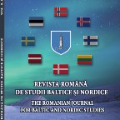The „soft” borders in the Baltic Sea Region, 1905-1940
The „soft” borders in the Baltic Sea Region, 1905-1940
Author(s): Silviu-Marian MiloiuSubject(s): Cultural history, Regional Geography, Historical Geography, Maps / Cartography, Military history, Political history, Social history, Pre-WW I & WW I (1900 -1919), Interwar Period (1920 - 1939)
Published by: Asociatia Romana pentru Studii Baltice si Nordice
Keywords: Baltic Sea Region; 20th century; discursive and emotional boundaries; soft borders; hard borders;
Summary/Abstract: Borders as imaginary or physical lines that serve as elements of separation (exclusion) and unification (inclusion) are widely discussed in fields such as history, international relations theory, international relations history, strategic studies, political science, and political geography, to name a few. Recent advances in the study of border problems have reshaped the conventional research paradigm in the fields of geography and political geography. This is why, in a study on the contemporary meanings of borders co-authored by numerous famous European and North American academics, an analysis of research paradigms, concepts, and future perspectives in border studies is offered. Corey Johnson and Reece Jones see borders as a complicated network of political, social, and cultural influences as long as sovereign states dominate the planet.This article will conduct an empirical examination of the Baltic Sea region's limits during the interwar period. It considers the complexities of borders as a twinning of political, social, cultural, economic, and psychological processes and occurrences, practically all of which are connected to a manifestation of power in its "hard" component. It is referred to as a "hard" border, pointing to the ones that divided Poland from Lithuania, or the Soviet Union from the Baltic States and the rest of the world, and as a "soft" or even "the softest" border, referring to the boundaries of the Scandinavian states during the same time period. As a complement to national ideologies, the notion of political and surveillance checkpoints would be an extension of Anssi Paasi's dual vision of discursive and emotional spaces (encompassing acquisition, exclusion, protection, love, hate, and violence). Liam O'Dowd's case for the need of understanding the history of state-building processes is compelling. While our study will concentrate on state and supranational processes, it will also examine border-related activities at the local and regional levels.
Journal: Revista Română de Studii Baltice şi Nordice
- Issue Year: 13/2021
- Issue No: 2
- Page Range: 85-120
- Page Count: 36
- Language: English

